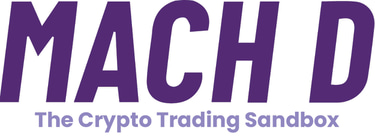Mastering Technical Indicators in a Crypto Sandbox: A Guide for Smarter Trading
At Mach D Trading, we know that navigating the crypto markets can be overwhelming—whether you’re a beginner testing the waters or an experienced trader refining your strategy. That’s why a crypto sandbox environment is the perfect place to experiment, learn, and perfect your trading approach without financial risk. By incorporating key technical indicators, traders can gain valuable insights, enhance decision-making, and build confidence before moving to live markets. In this blog, we’ll explore the top technical indicators to use in a sandbox setting, explaining how they work, why they’re essential, and how to integrate them into your trading strategy for smarter, more informed decisions.
BLOGS


What Is a Crypto Sandbox Environment?
A crypto sandbox is a simulated trading platform where traders can test strategies using virtual funds. This allows them to practice trading, analyse market movements, and evaluate performance—without financial risk.
By integrating technical indicators into your sandbox sessions, you can gain deeper market insights and improve your ability to identify trends, entry points, and potential reversals.
Top Technical Indicators for Sandbox Trading
1. RSI and MACD: Spotting Trend Reversals
📌 Purpose: Identifying divergences and confirming momentum shifts.
📌 Recommended Timeframe: 1 Hour (1H).
The Relative Strength Index (RSI) highlights overbought and oversold conditions, while the Moving Average Convergence Divergence (MACD) confirms momentum shifts. Together, they help traders detect potential trend reversals.
🔹 Why Use It in a Sandbox? Practicing with RSI and MACD sharpens your ability to recognize divergences—key signals of upcoming market changes.
2. SMA and RSI: Timing Your Trades
📌 Purpose: Identifying trend direction and entry/exit signals.
📌 Recommended Timeframe: 1 Day (1D).
The Simple Moving Average (SMA) smooths out price fluctuations to reveal trend direction. When paired with RSI, traders can pinpoint optimal entry and exit points based on overbought and oversold levels.
🔹 Sandbox Strategy: Test how RSI signals behave relative to the SMA trend to refine your trade timing.
3. Ichimoku and MACD: Trend Strength & Momentum Confirmation
📌 Purpose: Analysing long-term trends with momentum validation.
📌 Recommended Timeframe: 4 Hours (4H).
The Ichimoku Cloud offers a comprehensive market view, highlighting support, resistance, and trend strength. Adding MACD ensures momentum aligns with the overall trend.
🔹 Sandbox Tip: Experiment with Ichimoku’s cloud signals, such as Tenkan-Kijun crosses, while using MACD to confirm momentum direction.
4. Donchian and ATR: Confirming Breakouts
📌 Purpose: Identifying breakouts and measuring volatility.
📌 Recommended Timeframe: 1 Day (1D).
Donchian Channels track market highs and lows over a set period, helping traders spot breakout opportunities. Average True Range (ATR) adds an extra layer of validation by measuring volatility—ensuring breakouts have enough strength to be actionable.
🔹 Sandbox Practice: Avoid false breakouts by ensuring ATR confirms sufficient volatility before entering a trade.
5. Stochastic and MACD: Strengthening Momentum Signals
📌 Purpose: Identifying momentum shifts in trending markets.
📌 Recommended Timeframe: 1 Hour (1H).
The Stochastic Oscillator pinpoints overbought/oversold conditions, while MACD validates momentum shifts. Together, they provide powerful signals to filter out weak trade setups and avoid counter-trend trades.
🔹 Why It Matters: This combination is perfect for identifying high-probability trend entries in trending markets.
6. Ichimoku and RSI: Balancing Short-Term Momentum with Long-Term Trends
📌 Purpose: Analysing overall trend direction while fine-tuning trade timing.
📌 Recommended Timeframe: 4 Hours (4H).
Pairing Ichimoku’s trend analysis with RSI’s momentum signals helps traders determine whether short-term momentum supports the larger market trend.
🔹 Sandbox Application: Experiment with this pair to filter out low-probability trades and ensure momentum aligns with the broader trend direction.
Why Use Technical Indicators in a Sandbox?
✅ Risk-Free Learning – Make mistakes, refine strategies, and improve skills without financial loss.
✅ Build Confidence – Get comfortable interpreting key indicators before applying them in live markets.
✅ Develop Custom Strategies – Experiment with indicator combinations to create a trading approach tailored to your style.
✅ Understand Market Dynamics – Observe how indicators behave under different conditions, from trending to ranging markets.
Key Takeaways
✔️ Start simple – Begin with core indicators like RSI and MACD, then experiment with more advanced combinations.
✔️ Adjust timeframes – Test indicators on multiple timeframes to understand their impact in short-term vs. long-term trades.
✔️ Stay consistent – Use your sandbox time to refine strategies and evaluate performance metrics before transitioning to live markets.
Final Thoughts: Practice Smarter, Trade Smarter
A crypto sandbox is more than just a test environment—it’s your training ground. By incorporating top indicators like RSI, MACD, ATR, and Ichimoku, you can develop, refine, and optimise your trading approach with confidence.
🔹 Experiment, learn, and tailor strategies to fit your goals.
🔹 Master technical indicators before applying them in real-world trading.
🔹 The key to smarter trading tomorrow is smarter practice today.
Start using technical indicators in our sandbox today and take your trading to the next level!
Disclaimer
Markets are unpredictable—always test your strategies in a risk-free environment before investing real capital. This blog is for informational purposes only and does not constitute financial advice. Only trade with funds you can afford to lose. Mach D Trading makes no guarantees regarding the accuracy or completeness of the information provided.


